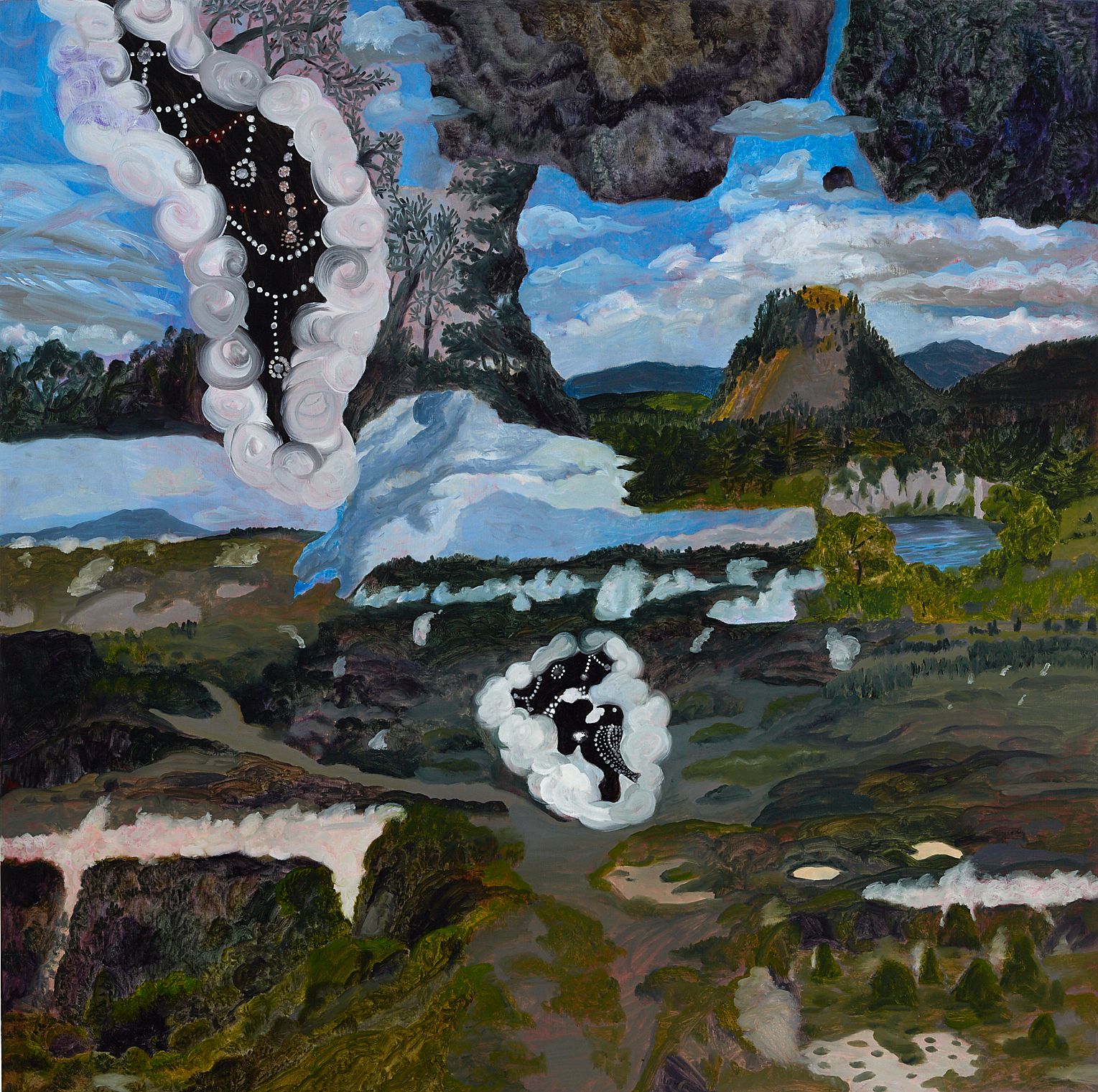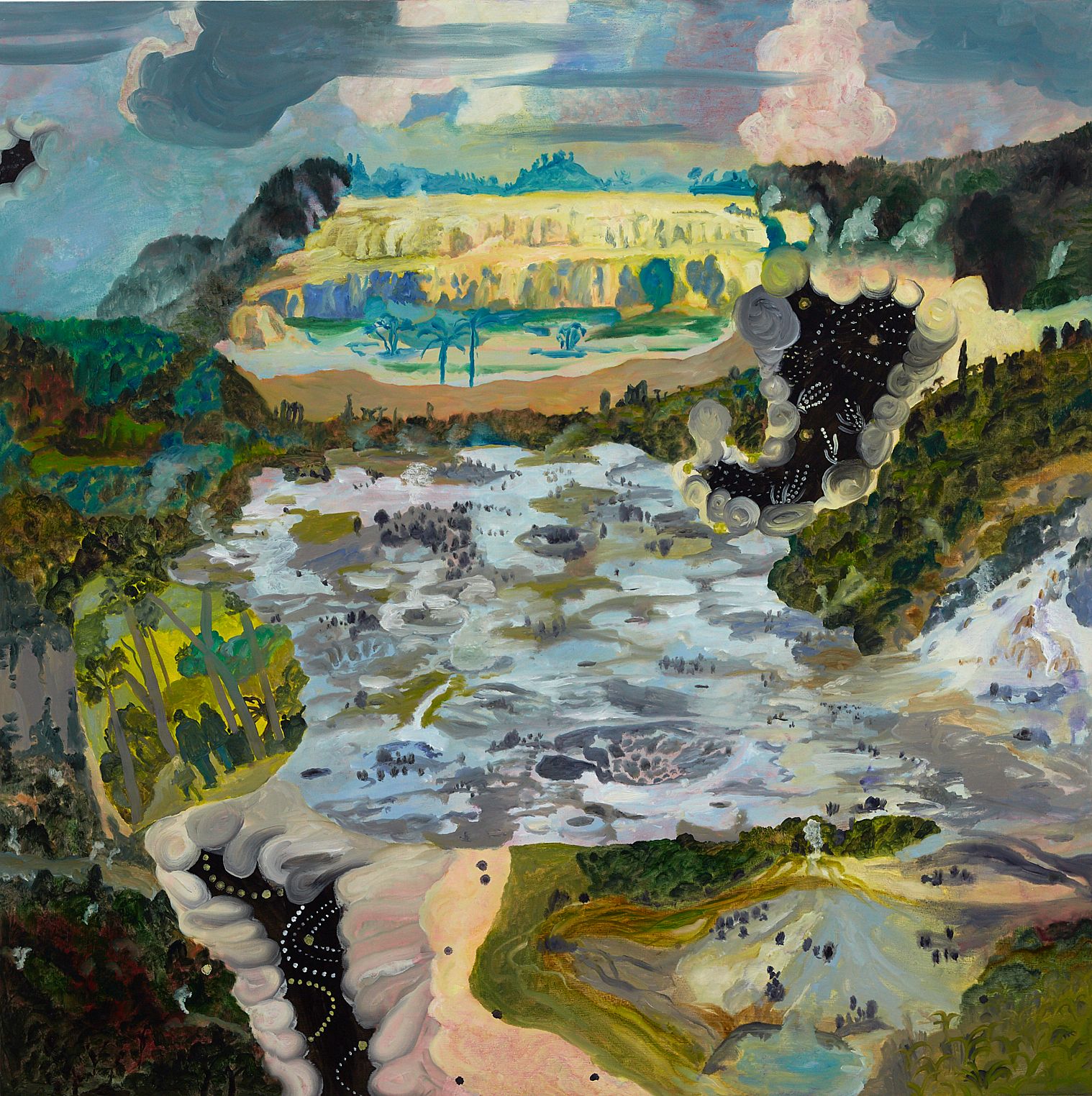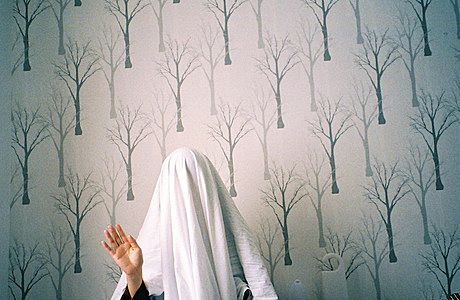Sublime Worlds: A Review of Barbara Tuck’s ‘Plume of Steam’
Jessica Douglas ruminates on the under-appreciated paintings of Barbara Tuck.
Jessica Douglas ruminates on the under-appreciated paintings of Barbara Tuck.
Ever since the birth of Instagram in 2010, we’ve been cropping and posting photos in a square-format. It makes sense, too, a square is a perfect ratio. It’s neat and tidy, it contains everything in one comprehensible, finite space, and it maintains its shape and format no matter which way you flip it. Even though you can now post rectangular photos on the social media app, the photos on your page’s account are always displayed in orderly little squares.
Much like Instagram, but long before the app was even created, Auckland-based painter Barbara Tuck has been adopting the use of the square-format for her majestic and tantalising canvases. Tuck recently said, “I like the sense of working within an equation… no longer being troubled by ‘the frame’.”[1] While Instagram’s aesthetic squares denote sleek precision, Tuck’s are a little less formulaic – though that is not to say that they are disorderly or careless. Rather, each work is unique and created with ravishing, meticulous care. They are completely alluring at first glance, and it doesn’t take long before they invite you to come in and take a closer look.
In her pictorial space Tuck creates a sublime world. One that is luscious and heady and filled with gemlike colours. This is especially true in her most recent suite of paintings, Plume of Steam, at Anna Miles Gallery. This series include six oil on board works, all 750 x 750mm.
These mysterious and enchanting works were created following Tuck’s most recent annual expedition to a ‘wild’ location. The 2016 expedition took her to the Rotorua region (twice), where 130 years earlier Mount Tarawera erupted and, in its wake destroyed villages, killing over one hundred people. The violent eruption also demolished the silica hot springs known as the Pink and White Terraces.
In Plume of Steam, Tuck presents her own imagining of the 1886 eruption and the Terraces. Hence, there couldn’t be a more appropriate title, with ‘plume’ meaning a long cloud of smoke or vapour which is feathery in appearance. Cloudscapes billow, sinter terraces glint in the distance, and succulent trees gather in thick cohorts. They are mystical, modern day impressions of Charles Blomfield’s and John Hoyte’s rendering of the eighth wonder of the world. (For more information read Rebecca Rice’s piece on works in Te Papa’s collection that feature the Pink and White Terraces and Mount Tarawera).
In her Plume of Steam works it appears that Māori in colonial dress and Pākehā in modern day clothing stand idly by. However, when I asked Tuck about this, she said, “I cannot presume what a viewer will take from a painting, only that it might shape consciousness in an unforeseen way… perception is a construct for all parties according to each individual”.[2] I had interpreted the figures this way as it was Māori who were most affected by the eruption. Perhaps others will take away an entirely different reading: Tuck, perhaps innocently, considers painting to, “emerge free of an agenda”.[3]
Given that just about all of her works are preoccupied with ecology and landscape, these figures may also allude to mankind’s ignorant destruction of the planet and the entropy of our ecosystem (Tim Low’s Where Song Began: Australia’s Birds and How They Changed the World (2014) is part of her current reading material). Like our ability to recall memories, ecology is something that fades and changes. That Tuck makes annual visits to lands might therefore suggest that these people also signify the role of fleeting impressions, of recollection, and of creating memory.
Many of Tuck’s landscapes in this exhibition favour her multiple stacked narratives, where different viewpoints and stories are grouped together in one canvas. At a distance the works could be abstract – you might even be tempted to play with their orientation and rotate them. In actuality, they are overlapping viewpoints and multiple horizon lines. The fact that Tuck is able to combine so many scenes into one space so seamlessly (and on a fairly intimate scale), demonstrates the true mark of her artistic capabilities.
Tuck has been reworking the two-dimensional picture space for the past fifty years, demonstrating her commitment to redefine the possibility of painting. Given this feat alone, it’s surprising she’s not more of a household name.
Furthermore, Tuck is able to marry so many opposing forces at one time. Her works are figurative and abstract, decorative but not fussy, subtle but forceful, and inviting but incisive to those who engage further. They are mysterious but somehow completely logical.
It is because of this that I am so taken with Barbara Tuck’s work, and particularly those in Plume of Steam. There is a certain mystique to them. They border between something enchanting and dreamy on the one hand, and something slightly darker and sinister, like a labyrinth on the other. Their glimmer pulls you in, but leaves you questioning your own understanding of perspective – both fictitious (Tuck’s) and real (the earth you stand on).
What is particularly eye-catching to this Plume of Steam series is the delicate dots and fine strokes of white (and sometimes red and yellow) paint atop small patches of browny-black. These areas are bordered by hazy licks of smoke, in which pink, white and grey heave and swirl. I would hazard a guess that these patches are the microbial mats and crystal deposits which would have been turned over following Tarawera’s deadly eruption (though similar dots did emerge in her 2015 Orients and Mortals series). While these organisms are sinister in nature, here they appear jewel- or lace-like and rather appealing. Similarly, although volcanic steam and mineral laden water are dangerous, here they are unquestionably inviting. Part of their charm is undoubtedly in the piquant colours.
In no expanse is there ever just one colour. Hues of green and blue intertwine with soft brown, and hints of peach, violet and seashell pink shimmer on the surface. Many facets of Tuck’s canvases recall the colours and shiny texture of an open oyster shell. Tuck says, “Any colour that surfaces is entirely random and becomes part of the uncertainty of that surface”.[4] It renders true, for me at least, that Tuck’s handling of colour is unlike any other. Admittedly, I do prefer these 2017 works to some of her earlier square-format ones, but that is simply because these colours are so delectable and paired extremely well.
Though similarities can be made throughout all of Tuck’s works in her five-decade career, each one tells its own story and each series tends to take on a new feature. Like the earth itself, Tuck’s pictorial worlds evolve throughout time. For instance, tall trees and soft blues escape in both her Plume of Steam and her 2005 Monkey Business series, but in the latter the paint seems thinner and softer as in a watercolour. The yellows and oranges in her 2012 Alice Capricious series bring to mind the acrid yellow in her 2008 Fieldwork Central series, but her Fieldwork pieces are looser and more abstracted, and the stacking narratives less dominant.
When Tuck shifted homes a little over a year ago, some of her Elam School of Fine Art works from circa 1965 were unearthed. The one that Anna Miles posted on her Instagram page demonstrates the continual threads that have been woven throughout Tuck’s oeuvre. For instance, this Elam artwork is similar in scale and format to her recent works, it attempts multiple viewpoints of multiple narratives, and it dares to be tilted or rotated. It may be a little bit rougher, with thicker, flatter brushstrokes and muddier and harder colours, but its relationship to her current body of work is undeniable. Another strong tie is the preoccupation with land and ecology, not only in depiction but also in theme.
American poet Jorie Graham is one of Tuck’s influences. Graham’s book P L A C E (2012) explores our intuition, imagination and experience of ‘place’ in navigating the world. Graham, much like Tuck, balances the act of looking back while we look ahead. In her poem ‘Earth’ Graham says, “across the tree-grain on the floor across those hundreds of/ years of molecules/ sucking-in water and light—/ this slightly/ C-shaped edge of the billion-light-year-toss-of-a-coin—/ sometimes trembling a/ bit if the shade/ lets in wind— /inexorably— …”[5]
Katherine Mansfield’s Urewera Notebook from her 1907 camping tour of the central North Island, written before she left colonial New Zealand permanently, also took Tuck’s interest. And science, nature and of course artists before her – both modern and the Old Masters – also help form Tuck’s subject and style. One can immediately see a connection to Scottish artist Peter Doig’s psychic landscapes, which are both inherently personal and laden in art historical references.
Tuck has been reworking the two-dimensional picture space for the past fifty years, demonstrating her commitment to redefine the possibility of painting. Given this feat alone, it’s surprising she’s not more of a household name.
Tuck posses an extremely adept artistic skillset, so why is it that most of us aren’t better acquainted with her name and her practice? For starters, she’s reserved and isn’t one for self-promotion. Even though social media is only a fairly recent phenomenon, its marketing prowess has unwittingly shaped all of our interests. Unfortunately, Tuck’s humble personality may have prevented her time in the limelight. Also, her practice was put on hold when she had children in the late 1960s. Although this was early on in her career, it would have consumed the next two decades of her life and disrupted her painting trajectory.[6]
At a deeper level, this lack of recognition is perhaps indicative of the gaps in art institution’s painting surveys. Interestingly, Tuck was the only artist in both Auckland Art Gallery Toi o Tāmaki’s recent Necessary Distraction exhibition (2015-16, curated by Natasha Conland) and their Surface Tension: Ten Artists in the ‘90s exhibition (1992, curated by Tina Barton, then known as ‘Auckland City Art Gallery’). What is revealing about these two exhibitions is their 23-year gap, leading me to question if more painting surveys were curated in national public galleries, would we have seen more of Tuck? The inclusion of Tuck in both of these exhibitions demonstrates the high calibre and consistency of her work. An artist who is yet to be fully appreciated.
Plume of Steam
Anna Miles Gallery
30 April 2017 – 20 May 2017
Exhibition Photographer: Sam Hartnett
All photographs courtesy of the artist and Anna Miles Gallery
[1] Barbara Tuck, quoted in Jill Treveylan, “Painted Ecologies: The Art of Barbara Tuck,” Art New Zealand, issue 159, Spring 2016, p. 94.
[2] Barbara Tuck, email to the author, 10 May 2017.
[3] Ibid.
[4] Barbara Tuck, email to the author, 7 May 2017.
[5] Jorie Graham, ‘Earth’, P L A C E (Great Britain: Carcanet/United States of America: Ecco, 2012) 65-66.
[6] Tuck, quoted in Treveylan, “Painted Ecologies”, p. 92.



